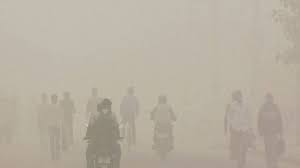Lagatar24 Desk
New Delhi: A thick haze and biting air gripped the national capital on Tuesday morning as post-Diwali pollution pushed Delhi’s air quality into the ‘Very Poor’ and ‘Severe’ categories, triggering widespread complaints of breathing problems and eye irritation among residents.
Locals Raise Alarm: “We Can’t Breathe”
Several Delhiites voiced concern over the plummeting air quality, blaming both public apathy and lax enforcement of green norms.
Sagar, a resident, said: “Everyone blames politicians, but people themselves need to take responsibility. Bursting firecrackers is a personal choice. Now people complain about the government while struggling to breathe and facing eye irritation.”
Ashish Ranjan, who had come to Kartavya Path for his morning run, shared a similar experience: “There are breathing difficulties while running. I can’t breathe properly.”
Another local emphasized shared accountability: “AQI control is a collective responsibility. Just government rules aren’t enough—society must cooperate. If we all followed orders like using only green crackers, things would improve.”
Surender Gupta recalled, “Pollution was lower last year. Yesterday I felt slight breathing discomfort, but today it’s worse.”
Delhi Chokes: AQI Crosses 400 in Several Areas
According to data from the Central Pollution Control Board (CPCB), Delhi’s overall AQI stood at 359 (Very Poor) at 10 AM on Tuesday. Several locations crossed into the ‘Severe’ zone (AQI > 400):
-
Bawana: 432
-
Jahangirpuri: 405
-
Ashok Vihar: 408
-
Wazirpur: 408
These levels are considered hazardous even for healthy individuals, with heightened risks for those with respiratory illnesses, children, and the elderly.
Understanding AQI Levels
-
0–50: Good
-
51–100: Satisfactory
-
101–200: Moderate
-
201–300: Poor
-
301–400: Very Poor
-
401–500: Severe
Green Crackers Policy & Government Response
Ahead of Diwali, the Supreme Court had allowed only green crackers in Delhi under strict guidelines. Despite this, widespread bursting of traditional fireworks was reported across the city.
To tackle the pollution surge, the Commission for Air Quality Management (CAQM) invoked Stage 2 of the Graded Response Action Plan (GRAP) across Delhi-NCR on Sunday.
However, many feel enforcement remains weak and public awareness insufficient.
Residents Call for Responsibility Over Rhetoric
While official advisories continue, residents like Ashish and Surender call for urgent action—both from the authorities and the public. “Only if individuals take responsibility,” one resident said, “can Delhi hope to breathe easy again.”









